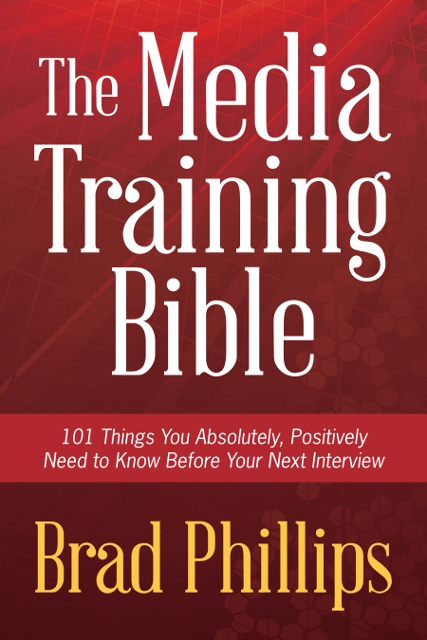Six Things You Should Know About Using Your Voice
This is an excerpt from my book, The Media Training Bible: 101 Things You Absolutely, Positively Need to Know Before Your Next Interview.
Most people don’t have a monotone vocal delivery. That’s the good news. The bad news is that most communicators use only a small portion of their available vocal range.
Our voices are incredible tools, capable of infusing great meaning into individual words and phrases. Simply by altering our volume, pitch, pace, and tone, we can better emphasize key points and help retain our audience’s attention.
Imagine you’re listening to the radio. The woman being interviewed is speaking at a moderate volume and average pace, but suddenly she slows down and almost whispers, “And right then, I knew I was in trouble.” By changing her vocal pattern, she signaled to the audience that something important was coming. We tend to do that in everyday life when we’re speaking with friends—and conversational is exactly what media interviews are supposed to sound like (even though they are not conversations).
Turn on a news radio station and listen to the way the anchors inject vocal variety into their verbal deliveries. Then practice for yourself by selecting a newspaper article and underlining a few key phrases that you want to emphasize verbally. Read the story aloud, and use your voice to highlight those phrases.
Keep these six things in mind for your vocal delivery:
- Volume: Speaking loudly adds energy and excitement to your delivery, while speaking softly increases intimacy and drama.
- Pace: Most people speak between 150 and 160 words per minute, but that number tends to increase when they get nervous. Speaking quickly can be useful if you’re trying to add excitement to a specific point, but be careful not to rush through your entire interview. Speak a little slower than usual when discussing more complicated information, emphasizing a key point, or building drama.
 Pitch: When you ask a question, your pitch usually goes up at the end of the sentence; when you give a command, your pitch goes down. People tend to speak with a higher pitch when they’re nervous or excited and with a lower pitch when they feel more relaxed and controlled. Both can be effective, but be careful to avoid vocal “upticks,” which occur when your pitch gets higher at the end of every sentence. An uptick makes you sound as if you’re seeking permission rather than making a statement—and too many of them will diminish your credibility.
Pitch: When you ask a question, your pitch usually goes up at the end of the sentence; when you give a command, your pitch goes down. People tend to speak with a higher pitch when they’re nervous or excited and with a lower pitch when they feel more relaxed and controlled. Both can be effective, but be careful to avoid vocal “upticks,” which occur when your pitch gets higher at the end of every sentence. An uptick makes you sound as if you’re seeking permission rather than making a statement—and too many of them will diminish your credibility.- Tone: Your tone adds emotion to words. For example, try saying aloud, “Sure, I love you,” three different ways: sincerely, sarcastically, and sadly. Those versions each convey something different, and good speakers align their words with the tone they wish to convey.
- Silences: Well-timed pauses can add drama to your vocal delivery or allow audiences an extra moment to consider your message. You can’t be silent for long periods of time, but even a one-second pause can be incredibly effective immediately before or after making a key point.
- Diaphragmatic Breathing: Take a deep breath. If your chest expands, you aren’t breathing correctly. Try it again, but as you breathe in, push your stomach out. Make sure your chest doesn’t move. Now begin talking and expending that air you’ve taken in. Your stomach should be moving in. That’s “diaphragmatic breathing,” and the benefits are enormous for the spoken word. Breathing properly makes your voice fuller, more resonant, and less nasal—and it gives you better breath control, meaning you won’t have to gasp for air as often.
The Media Training Bible is available from Amazon here and for the Kindle here. For other eBook formats, click here.

 Pitch: When you ask a question, your pitch usually goes up at the end of the sentence; when you give a command, your pitch goes down. People tend to speak with a higher pitch when they’re nervous or excited and with a lower pitch when they feel more relaxed and controlled. Both can be effective, but be careful to avoid vocal “upticks,” which occur when your pitch gets higher at the end of every sentence. An uptick makes you sound as if you’re seeking permission rather than making a statement—and too many of them will diminish your credibility.
Pitch: When you ask a question, your pitch usually goes up at the end of the sentence; when you give a command, your pitch goes down. People tend to speak with a higher pitch when they’re nervous or excited and with a lower pitch when they feel more relaxed and controlled. Both can be effective, but be careful to avoid vocal “upticks,” which occur when your pitch gets higher at the end of every sentence. An uptick makes you sound as if you’re seeking permission rather than making a statement—and too many of them will diminish your credibility.


I tell my students who have problems with pitch and inflection to practice singing their speeches. I don’t think many of them actually do it, but it’s a good way to explore one’s vocal range.
Amy –
That’s a terrific idea! Even if they don’t fully commit to the exercise, the small additional variety they add can improve their vocal delivery. Those who do commit may not only improve their range, but kill some of their fear of public speaking.
Hope all is well with you and your students at PSU-Harrisburg.
Brad
Brad, I must disagree with you about diaphragmatic breathing. When done correctly, the rib cage — chest — expands out as the diaphragm expands down and out. The shoulders should not move. There is no forcing here because the air that you inhale moves the ribs and the muscular partition.
Nancy,
Thank you for your comment. I’d like to hear more about this – we obviously want to get this right! The information I included in the story came from a long-time professional radio and television broadcaster – but if we’ve gotten that wrong, we’d like to correct it. What language would you suggest for that paragraph?
Thanks very much,
Brad